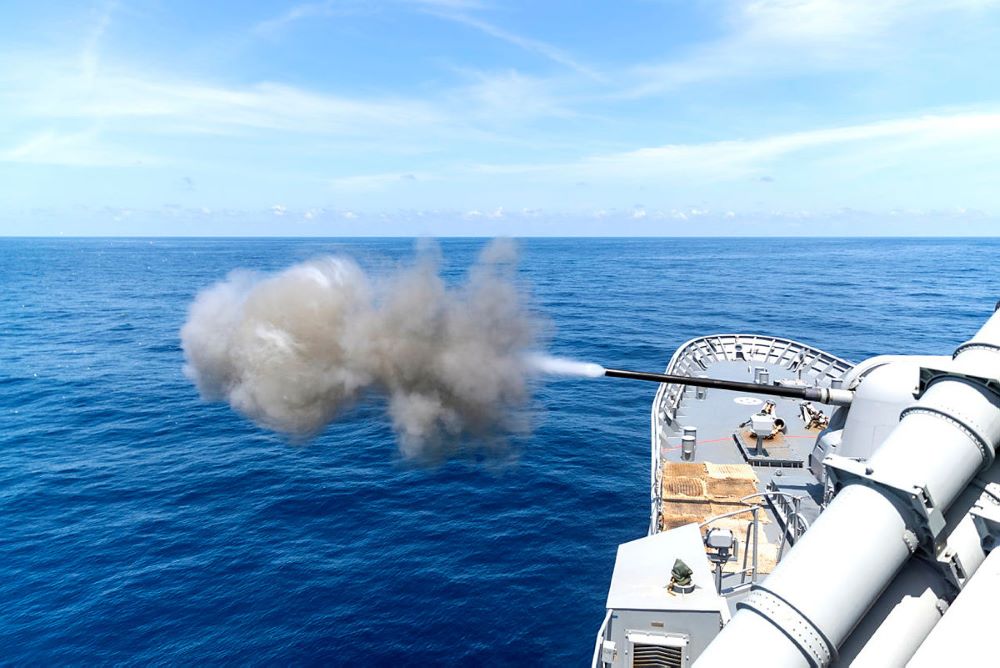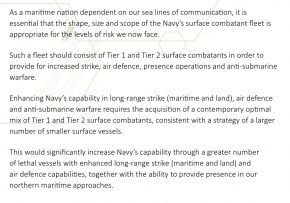I continue to think corvettes are a red herring. They are simply not suitable for our conditions.
Even if they do happen, they apparently won't be at the cost of the major surface combatants and will only be a small group of ships. IMO people are getting way worked up about the difference between say a OPV80 and a OPV90. Like its going to split the universe in half or something. Its literally a 10m larger ship from the same manufacturer and same designer.
Tier 1 and Tier 2 are clearly proper combatants. Tier two implies larger than an Anzac. Strike length missiles.
If you put all this together this indicates to me that the surface force will be the area getting significant investment over and above what has already been announced, and it may result in a modest cut in Hunters (maybe 9 to 6) but a significant increase in capability from 6 to 12 Tomahawk capable vessels - likely Type 31, Constellation or more Hobarts.
I don't see the point of changing the build from Hunters with 32 vls to Constellation with 32 vls or Type 31 with 24-32vls or even flight Hobarts with 48 VLS. There isn't enough capability difference. They are all frigates in literally the same classification and were all assessed for sea5000. They all have 100-150 crew. I am going to use a very crude and flawed metric, but it is simple. The VLS isn't the be all and end of of ships, larger ships tend to be more capable, smaller ships tend to be more compromised. Larger ships while using more crew, tend to offer more capability per crew member. This metric is flawed, Anzacs just carry ESSM. Burkes carry a whole bunch of ESSM, and land attack, and SM-6 and space attack sm-3. This also ignores main gun, torpedos, sonar, radar, helicopter, sea keeping, endurance, speed etc. But I want to illustrate where our problem is.
Anzac with 160 crew and 8 vls makes for 20 people per cell on ship
F-110 with 150 crew and 16 vls makes for 9.4 people per cell on ship
Mogami class has 90 crew and 16 vls makes for 5.625
Hunter/Constellation with 150 crew with 32 vls makes for 4.68 people per "cell on ship"
Type 31 with 100 crew with 32 vls makes for 3.125 per per "cell on ship"
Hobart with 200 crew with 48 vls makes for 4.17 people per "cell on ship"
Advanced Burke class (eg Maya) with 300 crew with 96 vls makes for 3.125 people per "cell on ship"
Our problem is the Anzacs. Those hard working robust little ships. All that robustness, endurance, tie up a large crew on a fairly small and limited ship. It has excellent sensors, they are great presence platforms, but they are not high end warfare platforms to throw high explosives at other threats, they are peace time platforms. You won't be loading LRASM, Tomahawk and SM-6 onto them. They aren't networked.
New more modern ships have more effective crewing. Its not just automation. Its more modern and reliable propulsion. Its better layout. Its the whole ship. Modern ships are designed to take modern sensors and systems, which are notoriously hard to retrofit.
Running peace time platforms into an armed region into war is bad. Expecting them to last until 2046 is absurdity. Even if the metal is plated over, it won't change the fundamentals of that small platform.
Hunter is not the problem, its a symptom. Of a slow decision process. We should have already replaced half the Anzacs by now. We haven't. We need to commit to pushing these hard working ships out of service and replacing them on a better 1 for 1.
Hobart doesn't exactly shift the much needle either. Arguing between Hobart's and Hunters is pointless. While Hobart has more VLS, it takes more crew. Hobart is a bigger platform with great sensors, but again, it limited by size, which limits endurance. You get less days at sea with that platform and require more logistics support. With only 3 of these, and these ships needing urgent upgrading for any sort of conflict, these have been an expensive acquisition, because we aimed so low and then watered the build down to 3. It should have been 6.
Having distributed tier 2 will result significantly less capability if we have tier 2 being anything less than Hunter. Tier 2 is hunter. Turning up to a China threat with anything less than Hunter is laughable. Turning up to a China threat, with just a single Hunter is also perhaps laughable.
Also lots of countries are already building ships like the Type 31. Will it get us where we need to be? What useful and unique capability will Australia bring to the fight if we bring?
Sounds like we need to commit to 18 ships.
Sounds like we need to work out what those 18 ships need to be a mix of.
Sounds like we need to fix ADF (not just RAN) man power issues. Take an 18th century organisation into the 21st century.
Sounds like we need a plan to build this capability a lot faster than 2046.
Sounds like we need a build plan for Henderson that goes past 2026.
I don't see how we can go forward, while so much resources/mindset are still tied up on Anzac and other legacy platforms.
We should have a informed public debate. Building ships isn't a secret. You build and tell the world so they know. Surface ships are bloody great big things that cost huge amounts of money and can be seen from space. There is basically nothing secretive about a ship building plan.
It is the physical manifestation of your defence policy in commitment of time, money, people and steel to build the bloody things. The very essence of gun boat diplomacy and naval power is the other side knows you have a gun boat.
That is why they occupy such an important place in national mindsets. It is a symbol of your national determinism to fight. At the moment what does our Navy say our about our country and our mindset? That we are fractured? That we can't commit to a program for more than one government, or even a single government, and our leadership changes more often than our underpants? That we can't select, build, or operate? That even if we do build that what we have isn't worth much in a fight?
If we don't get this sorted, we won't be fighting anyone, and we will loose. We will have lost while our plans are still tendering, being cancelled or on the design stage.
The Fact that even ASPI is spewing out papers who isn't sure where a C90 fits in and if its replacing a Hunter, or what is going on is worrying. Lots of people are shouting, and facts are thin on the ground. The DSR was meant to figure this out, but instead, more reviews. More delay. More confusion. More wasted money. More importantly more wasted time.


